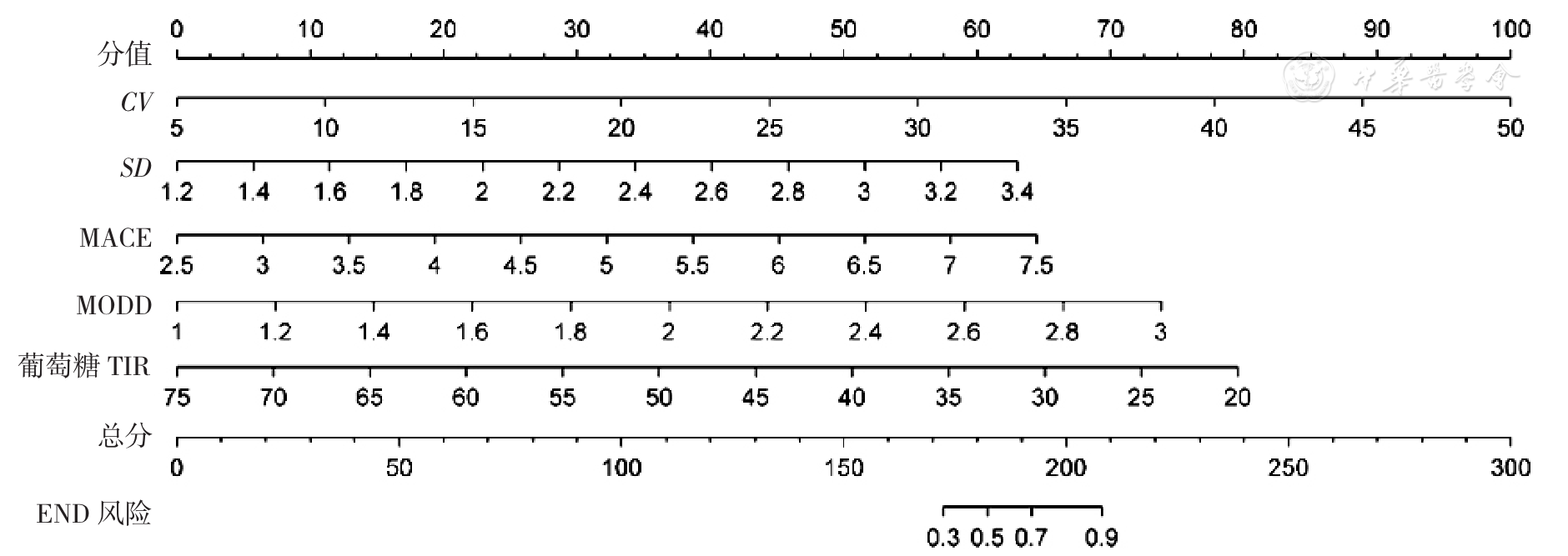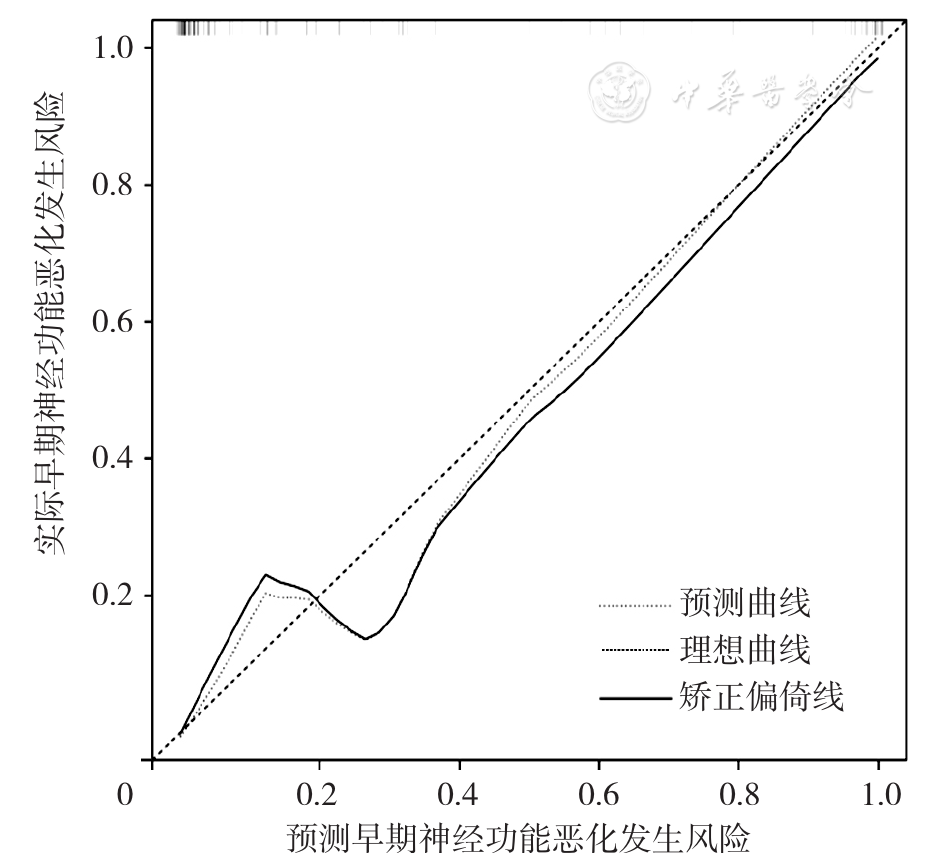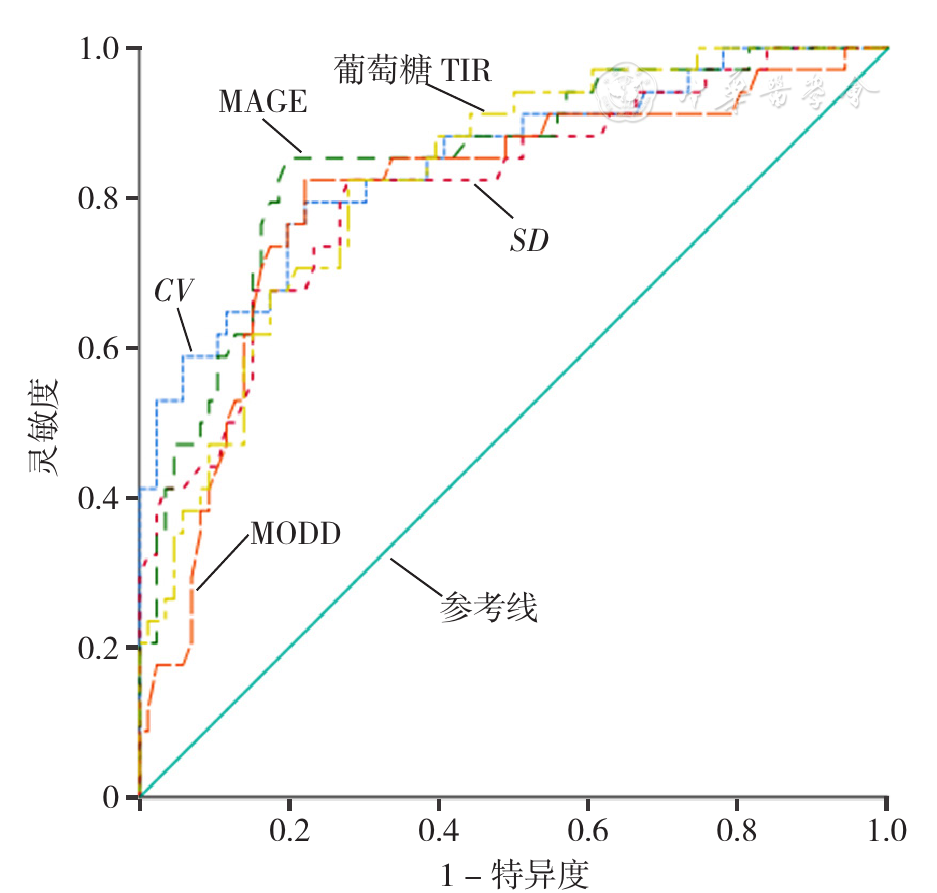

Chinese General Practice ›› 2022, Vol. 25 ›› Issue (12): 1418-1423.DOI: 10.12114/j.issn.1007-9572.2021.02.133
Special Issue: 内分泌代谢性疾病最新文章合集; 神经系统疾病最新文章合集
• Original Research • Previous Articles Next Articles
Received:2021-09-24
Revised:2021-11-15
Published:2022-01-13
Online:2022-03-21
Contact:
Xiaopeng YANG
About author:
通讯作者:
杨霄鹏
作者简介:基金资助:
Add to citation manager EndNote|Ris|BibTeX
URL: https://www.chinagp.net/EN/10.12114/j.issn.1007-9572.2021.02.133
| 指标 | END组(n=34) | 非END组(n=86) | 检验统计量值 | P值 | |
|---|---|---|---|---|---|
| 年龄( | 66.6±9.6 | 65.6±10.6 | -0.443 | 0.659 | |
| 性别(男/女) | 22/12 | 47/39 | 1.001a | 0.315 | |
| BMI( | 23.9±3.0 | 24.1±2.7 | 0.387 | 0.699 | |
| 吸烟史〔n(%)〕 | 9(26.47) | 26(30.23) | 0.167a | 0.683 | |
| 饮酒史〔n(%)〕 | 5(14.71) | 11(12.79) | 0.073a | 0.781 | |
| 既往病史〔n(%)〕 | |||||
| 高血压 | 25(73.53) | 55(63.95) | 1.001a | 0.316 | |
| 冠心病 | 6(17.65) | 11(12.79) | 0.473a | 0.492 | |
| 脑梗死 | 5(14.71) | 9(10.47) | 0.425a | 0.514 | |
| 高脂血症 | 20(58.82) | 45(52.33) | 0.414a | 0.520 | |
| 糖尿病病程( | 7.03±3.55 | 6.47±2.84 | -1.276 | 0.204 | |
| 治疗方式〔n(%)〕 | 2.327a | 0.508 | |||
| 饮食控制 | 9(26.47) | 16(18.60) | |||
| 口服降糖药物 | 16(47.06) | 38(44.19) | |||
| 皮下注射胰岛素 | 6(17.65) | 26(30.23) | |||
| 口服+皮下注射 | 3(8.82) | 6(6.98) | |||
| 空腹血糖( | 14.2±3.8 | 13.0±3.5 | -1.613 | 0.110 | |
| HbA1c( | 8.91±1.50 | 8.17±1.36 | 2.585 | 0.011 | |
| 总胆固醇( | 4.64±0.93 | 4.59±0.92 | -0.268 | 0.790 | |
| 三酰甘油( | 1.49±0.54 | 1.54±0.57 | 0.439 | 0.661 | |
| 高密度脂蛋白( | 0.97±0.26 | 1.00±0.24 | 0.623 | 0.548 | |
| 低密度脂蛋白( | 2.62±0.77 | 2.70±0.85 | 0.477 | 0.635 | |
| Hcy( | 13.65±4.30 | 12.24±4.02 | -1.698 | 0.092 | |
| 入院NIHSS评分〔M(P25,P75),分〕 | 4.00(2.00,7.00) | 2.00(1.00,4.00) | -2.418b | 0.016 | |
Table 1 Comparison of clinical data between patients with acute ischemic stroke and diabetes with and without early neurological deterioration
| 指标 | END组(n=34) | 非END组(n=86) | 检验统计量值 | P值 | |
|---|---|---|---|---|---|
| 年龄( | 66.6±9.6 | 65.6±10.6 | -0.443 | 0.659 | |
| 性别(男/女) | 22/12 | 47/39 | 1.001a | 0.315 | |
| BMI( | 23.9±3.0 | 24.1±2.7 | 0.387 | 0.699 | |
| 吸烟史〔n(%)〕 | 9(26.47) | 26(30.23) | 0.167a | 0.683 | |
| 饮酒史〔n(%)〕 | 5(14.71) | 11(12.79) | 0.073a | 0.781 | |
| 既往病史〔n(%)〕 | |||||
| 高血压 | 25(73.53) | 55(63.95) | 1.001a | 0.316 | |
| 冠心病 | 6(17.65) | 11(12.79) | 0.473a | 0.492 | |
| 脑梗死 | 5(14.71) | 9(10.47) | 0.425a | 0.514 | |
| 高脂血症 | 20(58.82) | 45(52.33) | 0.414a | 0.520 | |
| 糖尿病病程( | 7.03±3.55 | 6.47±2.84 | -1.276 | 0.204 | |
| 治疗方式〔n(%)〕 | 2.327a | 0.508 | |||
| 饮食控制 | 9(26.47) | 16(18.60) | |||
| 口服降糖药物 | 16(47.06) | 38(44.19) | |||
| 皮下注射胰岛素 | 6(17.65) | 26(30.23) | |||
| 口服+皮下注射 | 3(8.82) | 6(6.98) | |||
| 空腹血糖( | 14.2±3.8 | 13.0±3.5 | -1.613 | 0.110 | |
| HbA1c( | 8.91±1.50 | 8.17±1.36 | 2.585 | 0.011 | |
| 总胆固醇( | 4.64±0.93 | 4.59±0.92 | -0.268 | 0.790 | |
| 三酰甘油( | 1.49±0.54 | 1.54±0.57 | 0.439 | 0.661 | |
| 高密度脂蛋白( | 0.97±0.26 | 1.00±0.24 | 0.623 | 0.548 | |
| 低密度脂蛋白( | 2.62±0.77 | 2.70±0.85 | 0.477 | 0.635 | |
| Hcy( | 13.65±4.30 | 12.24±4.02 | -1.698 | 0.092 | |
| 入院NIHSS评分〔M(P25,P75),分〕 | 4.00(2.00,7.00) | 2.00(1.00,4.00) | -2.418b | 0.016 | |
| 组别 | 例数 | CV(%) | SD(mmol/L) | MAGE(mmol/L) | MODD(mmol/L) | 葡萄糖TIR(%) |
|---|---|---|---|---|---|---|
| END组 | 34 | 28.97±8.39 | 2.58±0.39 | 5.51±0.76 | 2.09±0.35 | 43.21±9.05 |
| 非END组 | 86 | 18.34±5.88 | 2.11±0.35 | 4.45±0.73 | 1.73±0.35 | 55.51±9.28 |
| t值 | 7.859 | 6.423 | 7.089 | 5.677 | -6.590 | |
| P值 | <0.001 | <0.001 | <0.001 | <0.001 | <0.001 |
Table 2 Comparison of glycemic variability indices and time in range measured by the 72-hour ambulatory continuous glucose monitoring between patients with acute ischemic stroke and diabetes with and without early neurological deterioration
| 组别 | 例数 | CV(%) | SD(mmol/L) | MAGE(mmol/L) | MODD(mmol/L) | 葡萄糖TIR(%) |
|---|---|---|---|---|---|---|
| END组 | 34 | 28.97±8.39 | 2.58±0.39 | 5.51±0.76 | 2.09±0.35 | 43.21±9.05 |
| 非END组 | 86 | 18.34±5.88 | 2.11±0.35 | 4.45±0.73 | 1.73±0.35 | 55.51±9.28 |
| t值 | 7.859 | 6.423 | 7.089 | 5.677 | -6.590 | |
| P值 | <0.001 | <0.001 | <0.001 | <0.001 | <0.001 |
| 因素 | β | SE | Waldχ2值 | P值 | OR值 | 95%CI |
|---|---|---|---|---|---|---|
| HbA1c | 0.190 | 0.282 | 0.456 | 0.499 | 1.210 | (0.696,2.102) |
| NIHSS评分 | 0.091 | 0.201 | 0.205 | 0.650 | 1.096 | (0.738,1.625) |
| CV | 0.177 | 0.077 | 5.341 | 0.021 | 1.194 | (1.027,1.388) |
| SD | 2.402 | 1.137 | 4.463 | 0.035 | 11.040 | (1.189,102.473) |
| MAGE | 1.119 | 0.541 | 4.287 | 0.038 | 3.063 | (1.062,8.837) |
| MODD | 3.044 | 1.374 | 4.908 | 0.027 | 20.990 | (1.420,201.206) |
| 葡萄糖TIR | -0.132 | 0.054 | 5.989 | 0.014 | 0.877 | (0.789,0.974) |
Table 3 Multivariate Logistic regression analysis of the influencing factors of early neurological deterioration in patients with acute ischemic stroke and diabetes mellitus
| 因素 | β | SE | Waldχ2值 | P值 | OR值 | 95%CI |
|---|---|---|---|---|---|---|
| HbA1c | 0.190 | 0.282 | 0.456 | 0.499 | 1.210 | (0.696,2.102) |
| NIHSS评分 | 0.091 | 0.201 | 0.205 | 0.650 | 1.096 | (0.738,1.625) |
| CV | 0.177 | 0.077 | 5.341 | 0.021 | 1.194 | (1.027,1.388) |
| SD | 2.402 | 1.137 | 4.463 | 0.035 | 11.040 | (1.189,102.473) |
| MAGE | 1.119 | 0.541 | 4.287 | 0.038 | 3.063 | (1.062,8.837) |
| MODD | 3.044 | 1.374 | 4.908 | 0.027 | 20.990 | (1.420,201.206) |
| 葡萄糖TIR | -0.132 | 0.054 | 5.989 | 0.014 | 0.877 | (0.789,0.974) |

Figure 1 Nomogram incorporating coefficient of variation,standard deviation,mean amplitude of glycemic excursion,mean of daily differences or time in range predicting early neurological deterioration in patients with acute ischemic stroke and diabetes mellitus

Figure 2 Internal validation of the predictive value of the nomogram for early neurological deterioration in patients with acute ischemic stroke and diabetes mellitus

Figure 3 ROC curves of coefficient of variation,standard deviation,mean amplitude of glycemic excursion,mean of daily differences and time in range predicting early neurological deterioration in patients with acute ischemic stroke and diabetes
| [1] |
|
| [2] |
|
| [3] |
|
| [4] |
|
| [5] |
|
| [6] |
|
| [7] |
|
| [8] |
|
| [9] |
中华医学会神经病学分会脑血管病学组急性缺血性脑卒中诊治指南撰写组. 中国急性缺血性脑卒中诊治指南2010[J]. 中华医学信息导报,2010,25(14):16-19. DOI:10.3760/cma.j.issn.1006-7876.2018.09.004.
|
| [10] | |
| [11] |
|
| [12] |
|
| [13] |
|
| [14] |
邓明群,周丽媛,翟笑,等. 扫描式葡萄糖监测系统中目标范围时间与糖化血红蛋白的相关性[J]. 协和医学杂志,2021,12(4):526-530.
|
| [15] |
|
| [16] |
|
| [17] |
|
| [18] |
|
| [19] |
|
| [20] |
|
| [21] |
冯亚莉,任彩琴,刘佼,等. 老年糖尿病患者血糖波动及其与缺血性脑卒中关系的研究进展[J]. 山东医药,2021,61(4):104-107.
|
| [22] |
|
| [23] |
|
| [24] |
|
| [25] |
|
| [1] | LI Dianjiang, PAN Enchun, SUN Zhongming, WEN Jinbo, WANG Miaomiao, WU Ming, SHEN Chong. The Current Status and Influencing Factors of Clinical Inertia in Type 2 Diabetes Patients in Community [J]. Chinese General Practice, 2023, 26(34): 4296-4301. |
| [2] | LIN Kai, YAO Mi, CHEN Zhang, JI Xinxin, LIN Runqi, CHEN Yongsong, Sim MOIRA. Conceptual Framework and Responding Approach of Treatment Burden of Type 2 Diabetes: a Video Recording-based Analysis [J]. Chinese General Practice, 2023, 26(34): 4302-4307. |
| [3] | YANG Hui, HU Ruwei, LIU Ruqing, LU Junfeng, WU Jinglan. Relationship between Community Health Service Experience and Glycemic Control Outcomes in Patients with Diabetes Mellitus [J]. Chinese General Practice, 2023, 26(34): 4290-4295. |
| [4] | ZHANG Juan, LI Haifen, LI Xiaoman, YAO Miao, MA Huizhen, MA Qiang. Construction of Recurrence Risk Prediction Model for Diabetic Foot Ulcer on the Basis of Logistic Regression, Support Vector Machine and BP Neural Network Model [J]. Chinese General Practice, 2023, 26(32): 4013-4019. |
| [5] | CHENG Jingwei, QIAO Junjun, YIN Zhen, HU Junpeng, WANG Qinghe, LIU Yangqing, WANG Yanfang. Interpretation of ISPAD Clinical Practice Consensus Guidelines 2022: Exercise in Children and Adolescents with Diabetes [J]. Chinese General Practice, 2023, 26(30): 3719-3724. |
| [6] | ZHOU Xiaoqi, LIU Xinhui, ZHANG Wei, LI Changfeng, YAN Yaqiong. Association of Alanine Transaminase and Aspartate Aminotransferase/Alanine Transaminase Ratio with Type 2 Diabetes and Metabolic Syndrome in the Elderly [J]. Chinese General Practice, 2023, 26(29): 3645-3649. |
| [7] | WANG Zhen, SHEN Guoqi, LI Yanan, ZHU Yinghua, QIU Hang, ZHENG Di, XU Tongda, LI Wenhua. Development and Validation of a Risk Prediction Model for Contrast-induced Acute Kidney Injury after Percutaneous Coronary Intervention in Patients with Acute Myocardial Infarction [J]. Chinese General Practice, 2023, 26(29): 3650-3656. |
| [8] | ZHAO Xiaohua, DU Lin, GAO Shengnan, JIANG Ziyun. Multiple Deep Muscle Abscesses in Type 2 Diabetes in the Elderly: Report of One Case and Literature Review [J]. Chinese General Practice, 2023, 26(29): 3715-3718. |
| [9] | LUO Dan, XU Jingjing, WANG Yubing, LI Mingzi, FORBES Angus. Development and Preliminary Practice of Resilience-oriented Structured Treatment and Educational Program for Adolescents with Type 1 Diabetes [J]. Chinese General Practice, 2023, 26(27): 3423-3429. |
| [10] | DONG Yanan, JIANG Xiaorui, WANG Kai, ZONG Chuanchong, LIN Guodong, LI Xiangqing, LIN Chunxiao, CHI Juntao. The Effect of Modified Tibial Transverse Transport Technique in the Treatment of Wagner Grade Ⅲ and Ⅳ Diabetic Foot Patients [J]. Chinese General Practice, 2023, 26(27): 3411-3416. |
| [11] | LIU Yue, LIU Qi, DONG Hui, LIU Yaling. Neuropsychological Changes of Cognitive Reverters after Stroke Based on the Montreal Cognitive Assessment (MoCA) with a Double Threshold [J]. Chinese General Practice, 2023, 26(27): 3417-3422. |
| [12] | WANG Xiaowen, XIAO Tongling, WANG Yi, YANG Ying, XIA Xiaoshuang, LI Xin. Relationship between Homocysteine Level and Acute Kidney Injury in Patients with Acute Ischemic Stroke [J]. Chinese General Practice, 2023, 26(26): 3290-3296. |
| [13] | GU Yunjie, SONG Jing, YIN Jun. Clinical Study on Low-carbon Diet for Endogenous-insulin-deficient Diabetes Patients [J]. Chinese General Practice, 2023, 26(26): 3308-3313. |
| [14] | KONG Dexian, XING Yuling, SUN Wenwen, ZHANG Zhimin, ZHOU Fei, MA Huijuan. Correlation between Estimated Glucose Disposal Rate and Metabolism-associated Fatty Liver Disease in Type 2 Diabetes [J]. Chinese General Practice, 2023, 26(26): 3252-3258. |
| [15] | LU Zuowei, CAO Hongwei, LIU Tao, ZHANG Nana, CHEN Yanyan, SHI Qinli, LIU Xiangyang, WANG Qiong, LAI Jingbo, LI Xiaomiao. Development and Validation of a Risk Prediction Model for the Progression from Microalbuminuria to Macroalbuminuria in Patients with Type 2 Diabetes Mellitus [J]. Chinese General Practice, 2023, 26(26): 3259-3268. |
| Viewed | ||||||
|
Full text |
|
|||||
|
Abstract |
|
|||||